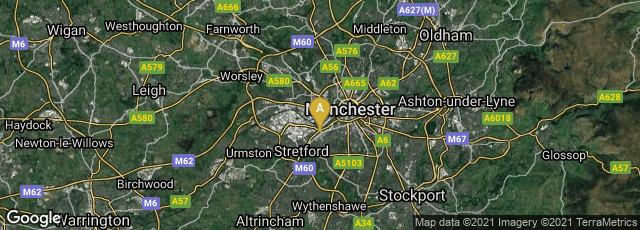

A: Old Trafford, Stretford, Manchester, England, United Kingdom
During 142 days, from May 5 to October 17, 1857 The Art Treasures of Great Britain exhibition held in Manchester, England, displayed over 16,000 works of art. It was the largest art exhibition ever held in the United Kingdom, and probably the largest art exhibition ever held anywhere. The exhibition attracted 1,300,000 visitors— more than the 827,000 who attended in the The Great Exhibition of the Works of Industry of All Nations, held from May 1 to October 11, 1851 at the Crystal Palace in London. One of the better published records of the exhibition was The Art-Treasures Examiner: A Pictorial, Critical, and Historical Record of the Art-Treasures Exhibition, at Manchester in 1857. Illustrated with two color-printed plates by Leighton and about 150 wood-engravings, this small folio work was issued by Alexander Ireland in Manchester and W.H. Smith in London.
In January 2015 a superb reproduction of a fine photograph of the main gallery of the exhibition taken by Leonida Caldesi and Mattia Montecchi was available from the John Rylands University Library at this link. This image was the first print after the contents page of the "Ancient Series" volume of the two-volume "Ancient" and "Modern" series, Photographs of the Gems of the Art Treasures Exhibition (London: Colnaghi & Agnew, 1858). That set published 200 photographs of what were considered some of the most significant items displayed.
"The exhibition was held outside the city centre. . . The site was conveniently adjacent to Manchester Botanical Garden and to the west of an existing railway line of the Manchester, South Junction and Altrincham Railway. The railway company built a new station (now Old Trafford Metrolink station) which was used by thousands of visitors from the city and from further afield on organised excursions. C.D. Young & Co, of London and Edinburgh – already engaged as builders of the new art museum in South Kensington (which later became the V [ictoria]& A[lbert]) – were appointed as contractors to build a temporary iron-and-glass structure similar to the Crystal Palace in London, 656 feet (200 m) long and 200 feet (61 m) wide, with one central barrel vault 56 feet (17 m) wide with a 24 feet (7.3 m) wide hip vault on either side roofing a 104 feet (32 m) wide central gallery running the length of the building, and narrower barrel vaults 45 feet (14 m) wide to either side, all crossed by a 104 feet (32 m) transept towards the western end.[9] The design of the main structure has been attributed to Francis Fowke,[10] who later designed the Natural History Museum in London, and an ornamental brick entrance at the eastern end was designed by local architect Edward Salomons. The materials used included 650 long tons (660 t) of cast iron, 600 long tons (610 t) of wrought iron, 65,000 square feet (6,000 m2) of glass and 1.5 million bricks.
"Internally, the building included a large hall, with corrugated iron sides and vaults supported by iron columns, with space for an orchestra at one end and a large pipe organ by Kirtland and Jardine. Each column bore the exhibition's monogram: "ATE". The hall was subdivided internally by partitions, creating separate galleries. The interior was lined with wood panels covered with calico. Most internal decoration was done by John Gregory Crace of London. A 24-foot (7.3 m) wide gallery ran around the transept at an upper level. The central third of each vault was glazed, providing ample diffuse light. In the summer, the glazing in the picture galleries was shaded with calico to prevent damage to the artworks, and firemen played water on the roof as a form of rudimentary air conditioning when the interior temperature exceeded 70 °F (21 °C). Young & Co's original quote of £24,500 proved over-optimistic, and cost overruns pushed the final bill up to £37,461" (Wikipedia article on Art Treasures Exhbition, Manchester 1857, accessed 08-25-2013).
"The exhibition comprised over 16,000 works split into 10 categories – Pictures by Ancient Masters, Pictures by Modern Masters, British Portraits and Miniatures, Water Colour Drawings, Sketches and Original Drawings (Ancient), Engravings, Illustrations of Photography, Works of Oriental Art, Varied Objects of Oriental Art, and Sculpture. The collection included 5,000 paintings and drawings by "Modern Masters" such as Hogarth, Gainsborough, Turner, Constable, and the Pre-Raphaelites, and 1,000 works by European Old Masters, including Rubens, Raphael, Titian and Rembrandt; several hundred sculptures; photographs, including Crimean War images by James Robertson and the photographic tableau Two Ways of Life by Oscar Gustave Rejlander; and other works of decorative arts, such as Wedgwood china, Sèvres and Meissen porcelain, Venetian glass, Limoges enamels, ivories, tapestries, furniture, tableware and armour. The Committee bought the collection of Jules Soulages of Toulouse, founder of the Société Archéologique du Midi de la France for £13,500 to form the core of the collection of medieval and Renaissance decorative arts. The collection had previously been exhibited at Marlborough House in London with a view to being acquired for the South Kensington Museum (now the V&A), but HM Treasury refused to fund the purchase. They were later acquired by the V&A.
"The works were organised chronologically, to demonstrate the development of art, with works from northern Europe on one wall contrasted with contemporaneous works from southern Europe on the facing wall. Although the collection included works from Europe and the Orient, it had a clear emphasis on British works.
"Most public British collections were in a nascent state, so most of the works were borrowed from 700 private collections. Many had never been exhibited in public before. The exhibition included the Madonna and Child with Saint John and the Angels, which had only recently been attributed to Michelangelo. The showing of this unfinished work caused much excitement, and it is still known as the Manchester Madonna" (Wikipedia. op. cit.).
Pergam, The Manchester Art Treasures Exhibition of 1857. Entrepreneurs, Connoiseurs and the Public (2011).